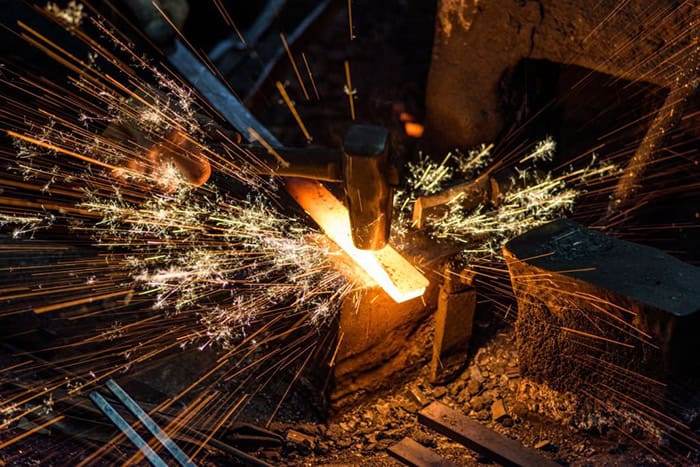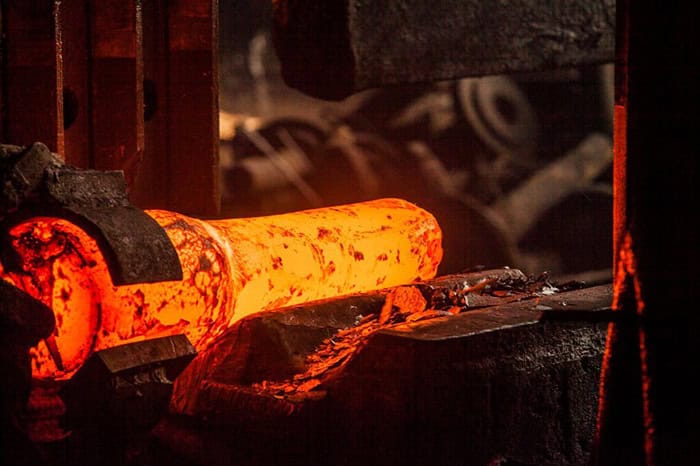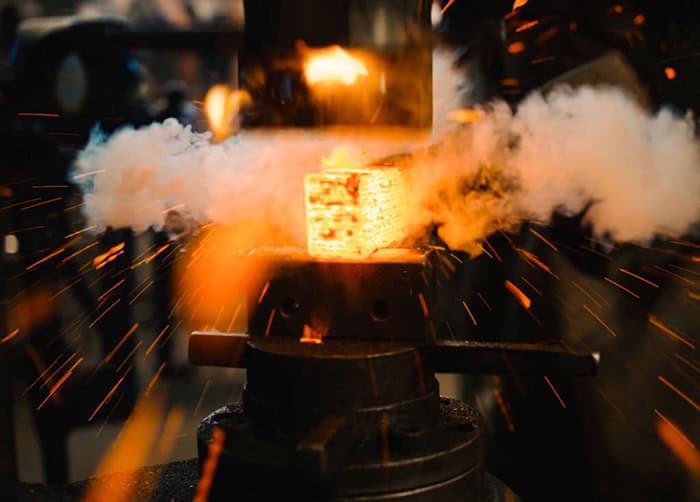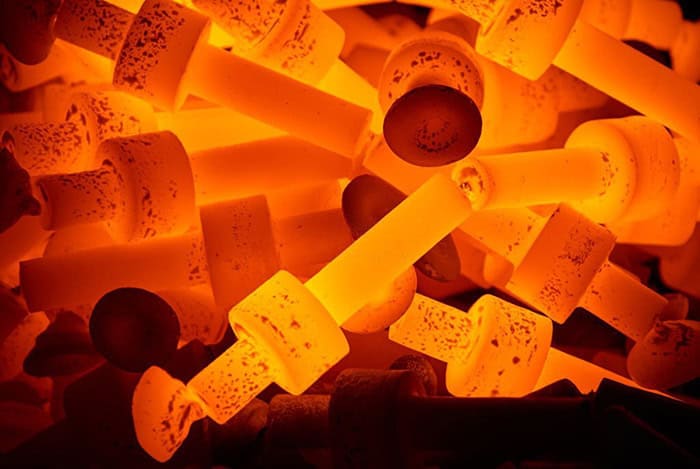Forged grade steelsare forged steels for the production of end-use products. The blending process consists of the transformation of the steel material into a designed shape at a higher stress rate. Forged-grade steels have a relative abrasion ability. This allows the steel to flow under unpressurized loading without breaking.Many carbon and low-alloy steels are generally considered to have a good donation, except for boiled and phosphorus quality. The difference in forging behavior between the various grades of steel is small enough, and therefore the choice of steel for forging is rarely affected by forging behavior.
What is Forged Steel?
Forged quality steels are steels forged for the production of end-use products. The blending process consists of the transformation of the steel material into a designed shape at a higher stress rate. Forged-grade steels have a relative abrasion ability. This allows the steel to flow under unpressurized loading without breaking.
Many carbon and low-alloy steels are generally considered to have a good donation, except for boiled and phosphorus quality. The difference in forging behavior between the various grades of steel is small enough, and therefore the choice of steel for forging is rarely affected by forging behavior.
Contrary to common knowledge, iron is usually a chemical element, and steel is used for all iron-based materials containing up to 2% carbon. Therefore, it is steel that is close to all the surrounding objects. Iron-based materials with a carbon content of more than 2% are called pig iron.
The beginning of the shaping technique, especially steel, copper and aluminum, continues for up to 4000 years by heating and beating the metal with a hammer until the metals soften. With the steam engines on, the use of overhead manpower was brought up so that the ship's propeller shafts would be made from very large machine parts such as the crankshaft of large engines. Thus, forged steel gained value.
However, many people in today's market are looking for an answer to the question of what is forged steel. what is steel and is looking for an answer.
Plastic formations at high temperature or room temperature are often called “blending” using compressive force. The blending process improves the mechanical properties of the part such as strength, toxicity and reduces the grain size. Most of the parts produced by blending are then treated with sawdust. Many parts such as bolts, rivets, bars, turbine shafts, coins, medals, gears, hand tools, pneumatic vehicle parts, auto parts, etc. are used for the production of forgings.

Forged Steel Stages and Properties
Different forging methods are used when forging steel. With the effect of this, it has many different cast steel properties. 3 different forging methods are available. These solutions are as follows:
- Hot forging – Blending in this process is usually done at a temperature of about 1200°C
- Hot blend – This process is normally carried out at temperatures ranging from 650°C to 750°C, below the crystallization temperature of the steel
- Cold Forging – This is done at room temperature and the steel material does not heat up.
The qualities required in forged steels during forging are critical and difficult because high tensile ratios are used. Other blending components require special processes to provide special properties according to the final application of the blending processes. In addition, since the end-use of forged steel products is critical, strict control is required at all stages of the steelmaking process.
Forged Steel Selection
The choice of steel type for a forged component is an integral part of the blending process and its acceptable performance after forged steel depends on this option. A thorough understanding of the final use of the finished part serves to define the mechanical elements required, the surface finish requirements, the tolerance to non-metallic containers, and the inspection methods and criteria assigned.
The choice of steel for forging normally requires some compromise between the opposite factors. These counter factors include resistance to toxicity, corrosion resistance to weight, load-bearing capacity, and the price of forging against the cost of steel, etc. Pay attention to the blending and blending processes required by the final product. Forged steels should have the following metallurgical properties.
- Surface Quality
- Good Cleaning
- Good internal quality
- Good potency toxicity
- Fine and smooth austenitic particles
- Good response to thermal therapy
The quality steel forging buyer sets one or more specific quality restrictions for the steel according to their needs. These restrictions, in a way, brought about the need for extra testing for the steelmaker. Forged quality steels are produced in a wide variety of chemical compounds with basic oxygen therapy and electric arc furnace steel production. Each eraser and rolling application uses a level of test and evaluation quality. The test and quality evaluation details vary from manufacturer to manufacturer and should be the point of enquiry when batching steels are ordered.

Forged Steel Production
Forged steel is also produced in many different categories. This diversity also directly affects and increases the production of stainless steel. The categories are as follows:
- Production of flat carbon steel
- Production of carbon manganese steel
- Production of molybdenum manganese steel
- Production of flat chrome steel
- Production of chromium manganese steel
- Production of chromium molybdenum steel
- Production of chrome nickel steel
- Production of chromium molybdenum steel
Carbon, micro-alloy and alloy steel forgings produce the highest amount of forgings for a wide range of applications. Stainless steel is widely used in applications up to about 510°C where heat and corrosion resistance is required. The material selected for the forging application should be a material that can provide the desired physical and mechanical properties. Where alloys in various groups meet performance requirements, the most economical alloy should be selected in terms of material and processing costs.

How is Forged Steel Produced?
The application of steel casting dates back to the end of 1750, much later than other metals. The high melting point of steel and the lack of available technology to melt and process metals delayed the development of the steel casting industry. These challenges were overcome by advances in furnace technology.
Ovens are refractory coated containers containing "load" material for melting and providing energy for melting. There are two types of furnaces used in the modern steel foundry: electric arc and induction.
Electric Arc Furnace: The electric arc furnace melts the metal stacks called "heating" of the electric arc between the graphite electrodes. The charging process goes directly through the electrodes and is exposed to thermal energy from the ongoing electrical discharge. Electric arcs follow the operation of the tap and the process continues with stages such as baking, melting, thinning.
Induction Furnace: The induction furnace is an electric furnace in which heat energy is induced. An alternating current passes through the winding to form a copper coil surrounding the non-conductive charging container and electromagnetic induction within the charge.
Induction furnaces can melt most metals and can be operated with minimal melting loss. The disadvantage is that very little metal can be refined. Unlike an electric arc quarry, steel cannot be converted.
Modern steel foundries often use recycled steel scrap to reduce the cost and environmental impact of casting production. Old cars, mechanical parts and similar materials are separated, sized and sent to the foundry as scrap. This is combined with the internal scrap produced in the casting process and combined with various alloying elements to fill the melting furnace. This process is followed by stages such as heat treatment, annealing, normalization, quenching and tempering.
How Does the Forged Steel Control Stage Work?
Steel castings are often inspected to verify certain physical properties, such as dimensional accuracy, cast surface quality, and internal rigidity. The chemical composition should also be checked. The chemical composition is greatly influenced by small alloying elements added to the material. Cast steel alloys are sensitive to variations of chemical compounds, so chemical analysis is required to verify their exact chemical composition prior to casting. A small sample of molten metal is poured into the mould and analyzed.
Afterwards, quality control process is provided and approved on issues such as dimensional accuracy, surface quality, internal robustness. A careful production and control process works against any defects or faults. As a result, the quality ones and the defective ones are separated.

